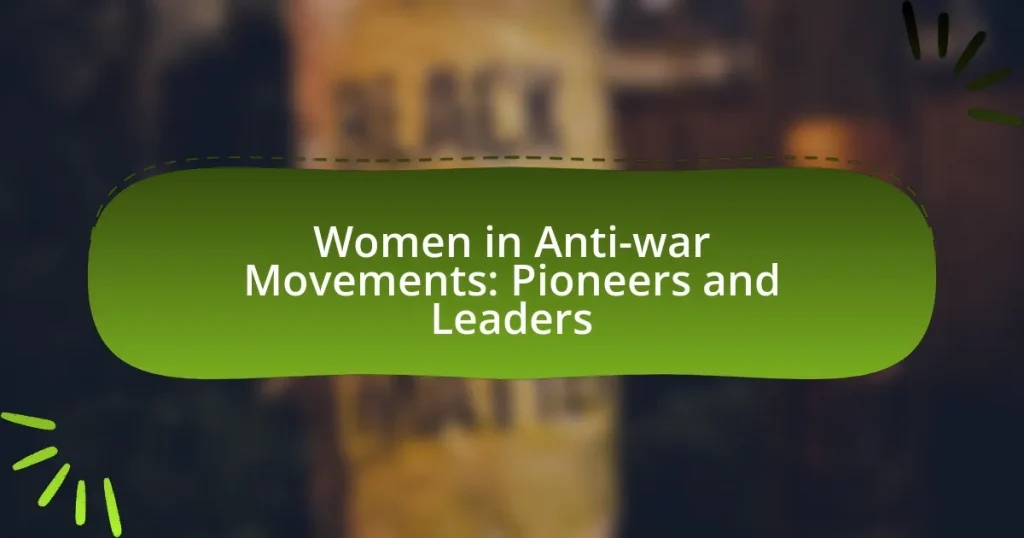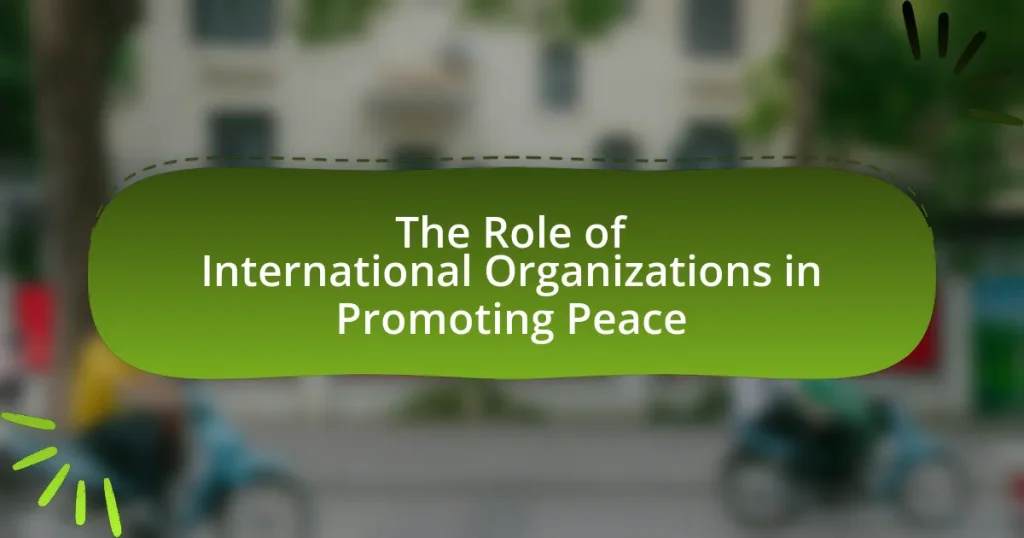Peace treaties are formal agreements designed to end hostilities and establish lasting peace between conflicting parties. This article analyzes the effectiveness of peace treaties in conflict resolution, highlighting their key components, such as ceasefires, territorial adjustments, and political arrangements. It examines historical examples, including the Treaty of Versailles and the Camp David Accords, to illustrate how these treaties can reshape nations and influence future relations. Additionally, the article discusses factors that affect treaty success, challenges in implementation, and best practices for enhancing their effectiveness, emphasizing the importance of inclusive negotiation processes and robust monitoring mechanisms.
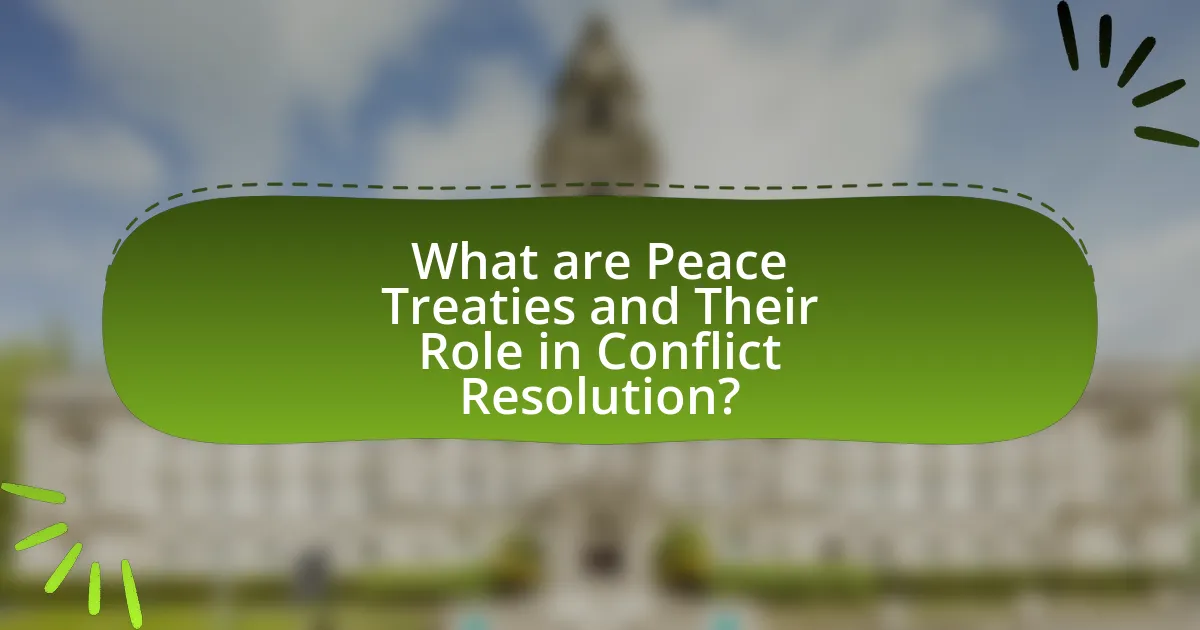
What are Peace Treaties and Their Role in Conflict Resolution?
Peace treaties are formal agreements between conflicting parties aimed at ending hostilities and establishing lasting peace. These treaties typically outline terms for ceasefires, territorial adjustments, reparations, and political arrangements, serving as a framework for conflict resolution. Historical examples, such as the Treaty of Versailles in 1919, demonstrate how peace treaties can reshape nations and influence future relations. The effectiveness of peace treaties in conflict resolution is often measured by their ability to prevent the resurgence of violence, as seen in the successful implementation of the Camp David Accords between Egypt and Israel in 1978, which led to a lasting peace between the two nations.
How do peace treaties function in the context of ending conflicts?
Peace treaties function as formal agreements between conflicting parties to cease hostilities and establish terms for peace. These treaties typically outline the conditions for ending the conflict, including territorial adjustments, reparations, and political arrangements. Historical examples, such as the Treaty of Versailles in 1919, demonstrate how peace treaties can reshape national boundaries and influence future relations, although they can also lead to unresolved tensions, as seen in the aftermath of World War I. The effectiveness of peace treaties in ending conflicts often hinges on the commitment of the involved parties to adhere to the agreed terms and the presence of mechanisms for enforcement and dispute resolution.
What are the key components of a peace treaty?
The key components of a peace treaty include the cessation of hostilities, territorial agreements, disarmament provisions, political arrangements, and mechanisms for dispute resolution. Cessation of hostilities ensures that fighting stops immediately, while territorial agreements define borders and control over land. Disarmament provisions outline the reduction or elimination of weapons, which is crucial for long-term peace. Political arrangements often involve power-sharing or governance structures to address the needs of conflicting parties. Finally, mechanisms for dispute resolution provide a framework for addressing future conflicts, ensuring that the treaty remains effective over time. Historical examples, such as the Camp David Accords in 1978, illustrate how these components can lead to lasting peace by addressing the core issues between conflicting parties.
How do these components contribute to conflict resolution?
The components of peace treaties contribute to conflict resolution by establishing clear terms for cessation of hostilities, outlining mutual obligations, and creating mechanisms for enforcement and monitoring. These elements facilitate trust-building between conflicting parties, as evidenced by the Dayton Agreement, which ended the Bosnian War in 1995 by providing a structured framework for political cooperation and territorial integrity. Additionally, the inclusion of third-party mediators in treaties, such as the Camp David Accords, enhances accountability and ensures compliance, further promoting lasting peace.
What historical examples illustrate the effectiveness of peace treaties?
The Treaty of Versailles, signed in 1919, effectively ended World War I and established the League of Nations, aiming to prevent future conflicts. This treaty marked a significant shift in international relations, as it sought to create a framework for peace through collective security. Another example is the Camp David Accords of 1978, which facilitated peace between Egypt and Israel, leading to the first recognition of Israel by an Arab state and a lasting peace agreement. Additionally, the Good Friday Agreement of 1998 successfully addressed decades of conflict in Northern Ireland, establishing a devolved government and promoting cooperation between communities. These treaties demonstrate the potential of diplomatic agreements to resolve conflicts and foster long-term stability.
Which peace treaties are considered successful, and why?
The Treaty of Versailles, signed in 1919, is often considered successful in formally ending World War I, as it established the League of Nations and redrew national boundaries, although its long-term effectiveness is debated. The Camp David Accords, signed in 1978 between Egypt and Israel, are regarded as successful due to their role in achieving lasting peace between the two nations, evidenced by Egypt’s recognition of Israel and the return of the Sinai Peninsula to Egypt. The Good Friday Agreement of 1998 is also viewed as successful, as it significantly reduced violence in Northern Ireland and established a devolved government, leading to a more stable political environment. Each of these treaties is considered successful because they not only ended immediate hostilities but also laid the groundwork for future diplomatic relations and stability.
What lessons can be learned from unsuccessful peace treaties?
Unsuccessful peace treaties highlight the importance of inclusive negotiation processes. When key stakeholders are excluded, as seen in the Treaty of Versailles in 1919, it can lead to resentment and future conflict. Additionally, the failure to address underlying issues, such as economic disparities or historical grievances, often results in a lack of lasting peace, exemplified by the Oslo Accords, which did not resolve core issues between Israelis and Palestinians. Furthermore, the lack of enforcement mechanisms can render treaties ineffective, as demonstrated by the inability to uphold the Dayton Agreement in Bosnia, leading to renewed tensions. These lessons emphasize the need for comprehensive, inclusive, and enforceable agreements to achieve sustainable peace.
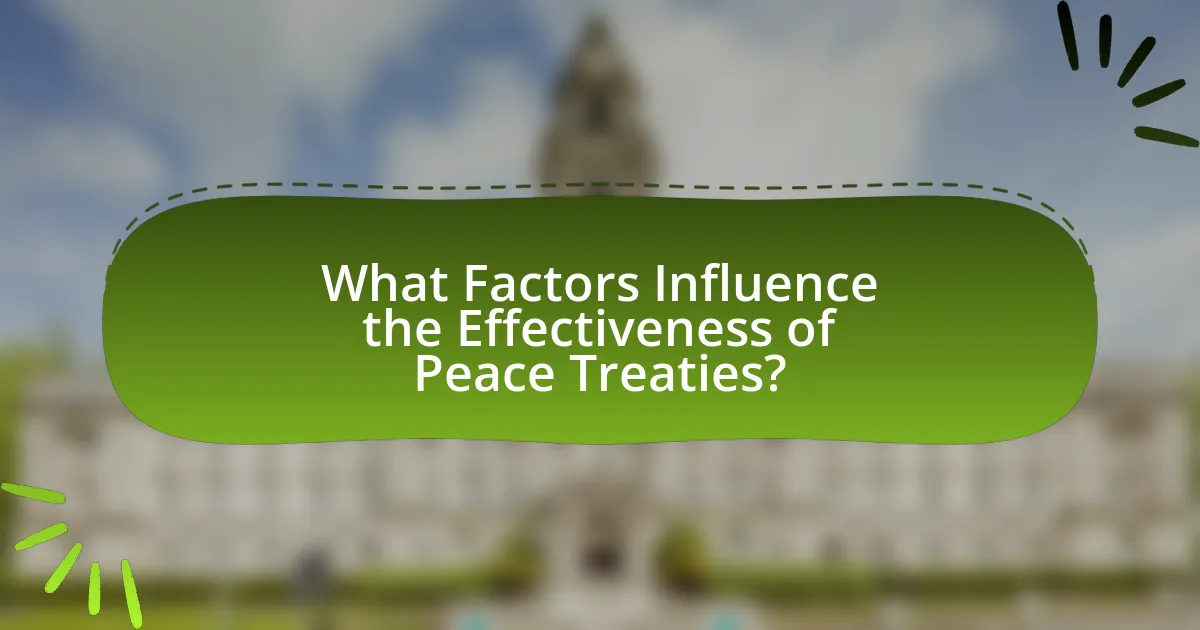
What Factors Influence the Effectiveness of Peace Treaties?
The effectiveness of peace treaties is influenced by several key factors, including the commitment of the parties involved, the presence of enforcement mechanisms, and the socio-political context. Commitment is crucial; for instance, the 1993 Oslo Accords between Israel and the Palestine Liberation Organization highlighted that mutual willingness to adhere to terms significantly impacts long-term success. Enforcement mechanisms, such as international oversight or sanctions for non-compliance, can also enhance effectiveness, as seen in the Dayton Agreement that ended the Bosnian War, which included NATO’s role in maintaining peace. Lastly, the socio-political context, including public support and the stability of governments involved, plays a vital role; the 2005 Comprehensive Peace Agreement in Sudan faced challenges partly due to ongoing internal divisions and lack of popular backing. These factors collectively determine whether peace treaties can successfully end conflicts and foster lasting peace.
How do the parties involved affect the outcome of peace treaties?
The parties involved significantly influence the outcome of peace treaties through their interests, power dynamics, and commitment levels. For instance, when parties possess equal power and mutual interests, they are more likely to reach a sustainable agreement, as seen in the Camp David Accords between Egypt and Israel in 1978, where both sides had strong incentives to negotiate. Conversely, if one party is significantly stronger or has divergent interests, the resulting treaty may be imbalanced or fail to address key issues, leading to future conflicts, as evidenced by the Treaty of Versailles in 1919, which imposed harsh penalties on Germany and contributed to World War II. Thus, the nature of the parties involved directly shapes the negotiation process and the durability of the resulting peace treaty.
What role do power dynamics play in the negotiation process?
Power dynamics significantly influence the negotiation process by determining the leverage and influence each party holds. In negotiations, parties with greater power can dictate terms, control the agenda, and shape outcomes more effectively than those with less power. For instance, in peace treaty negotiations, a stronger party may impose conditions that favor its interests, while a weaker party may have to concede more to reach an agreement. Research by William Zartman in “Negotiation and Conflict Management” highlights that power imbalances can lead to unequal agreements, often resulting in instability and future conflicts if the weaker party feels marginalized. Thus, understanding and addressing power dynamics is crucial for achieving equitable and lasting agreements in negotiations.
How does the level of commitment from parties impact treaty success?
The level of commitment from parties significantly impacts treaty success by determining the likelihood of adherence to agreed terms. High commitment levels foster trust and cooperation, which are essential for effective implementation and long-term stability. For instance, the 1998 Good Friday Agreement in Northern Ireland succeeded largely due to the strong commitment from both the British and Irish governments, alongside local parties, which led to a sustained peace process. Conversely, low commitment can result in violations and conflicts, as seen in the 1994 ceasefire in the Israeli-Palestinian conflict, where lack of commitment from key parties led to repeated breakdowns. Thus, the degree of commitment directly correlates with the durability and effectiveness of peace treaties.
What external factors can influence the success of peace treaties?
External factors that can influence the success of peace treaties include international support, economic conditions, and the involvement of third-party mediators. International support, such as backing from major powers or organizations like the United Nations, can provide legitimacy and resources necessary for implementation. Economic conditions, including the availability of financial aid or investment, can affect the stability and sustainability of peace. The involvement of third-party mediators can facilitate dialogue and help resolve disputes, as seen in the Camp David Accords, where U.S. mediation was crucial in achieving peace between Egypt and Israel.
How do international organizations contribute to peace treaty effectiveness?
International organizations enhance peace treaty effectiveness by providing mediation, monitoring, and support for implementation. For instance, the United Nations often facilitates negotiations between conflicting parties, ensuring that all voices are heard and fostering a collaborative environment. Additionally, organizations like the Organization for Security and Co-operation in Europe (OSCE) deploy observers to monitor compliance with treaty terms, which helps to build trust among parties. Research indicates that peace agreements with international organization involvement are 20% more likely to last at least two years compared to those without such support, demonstrating their critical role in sustaining peace.
What impact do economic conditions have on the sustainability of peace treaties?
Economic conditions significantly impact the sustainability of peace treaties by influencing the resources available for implementation and the public’s support for peace. When economic stability is present, governments can allocate funds for reconstruction, development, and social programs that reinforce peace. Conversely, economic downturns can lead to resource scarcity, increased unemployment, and social unrest, undermining the commitment to uphold peace agreements. For instance, the 1995 Dayton Agreement in Bosnia faced challenges due to economic difficulties, which fueled ethnic tensions and hindered the peace process. Thus, robust economic conditions are essential for fostering an environment conducive to the long-term success of peace treaties.
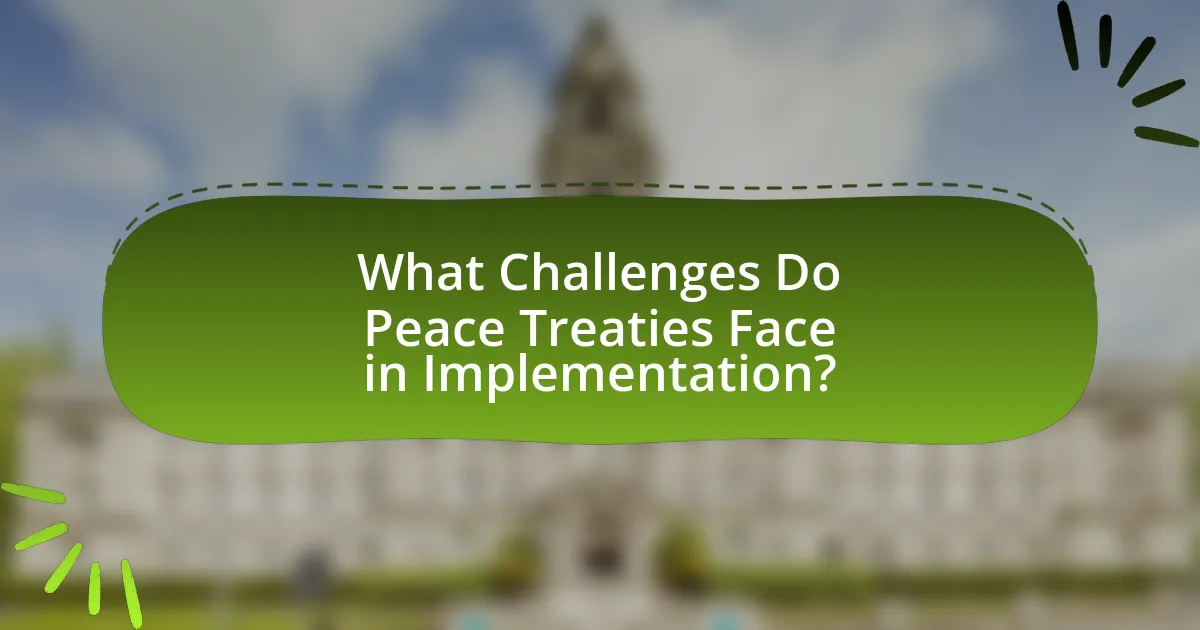
What Challenges Do Peace Treaties Face in Implementation?
Peace treaties face several challenges in implementation, primarily due to lack of trust among parties, insufficient enforcement mechanisms, and differing interpretations of treaty terms. For instance, historical examples such as the Treaty of Versailles in 1919 illustrate how punitive measures can lead to resentment and non-compliance, undermining peace efforts. Additionally, the absence of a robust international body to oversee compliance often results in violations, as seen in the case of the Dayton Agreement, where ongoing ethnic tensions hindered full implementation. These factors collectively contribute to the difficulties in translating peace agreements into lasting peace.
What are common obstacles to the implementation of peace treaties?
Common obstacles to the implementation of peace treaties include lack of trust among parties, insufficient political will, and the presence of ongoing violence. Lack of trust can hinder cooperation, as parties may doubt each other’s commitment to the terms. Insufficient political will often arises from domestic pressures or competing interests that prioritize short-term gains over long-term peace. Ongoing violence, such as insurgent attacks or retaliatory actions, can disrupt the peace process and create a cycle of conflict, making it difficult to adhere to treaty provisions. Historical examples, such as the failure of the 1993 Oslo Accords due to mutual distrust and violence, illustrate these challenges in practice.
How do political instability and lack of trust hinder implementation?
Political instability and lack of trust significantly hinder the implementation of peace treaties by creating an environment where stakeholders are unwilling to commit to agreements. When a government is unstable, it often lacks the authority and capacity to enforce treaty provisions, leading to non-compliance. For instance, in countries like Syria and Libya, ongoing political turmoil has resulted in the failure to uphold ceasefires and other treaty obligations, as factions do not trust the intentions of their rivals or the government. Additionally, a lack of trust among parties can lead to skepticism about the benefits of compliance, as seen in the Israeli-Palestinian conflict, where historical grievances fuel doubts about the sincerity of peace efforts. This combination of instability and distrust ultimately undermines the effectiveness of peace treaties, as parties may prioritize short-term survival over long-term commitments to peace.
What role do non-state actors play in undermining peace treaties?
Non-state actors significantly undermine peace treaties by engaging in violent opposition, influencing public opinion, and perpetuating conflict dynamics. For instance, armed groups, such as militias or terrorist organizations, often reject the terms of peace agreements, leading to renewed violence and instability, as seen in the case of the FARC in Colombia, which continued hostilities despite a peace deal in 2016. Additionally, non-state actors can sway local populations against peace initiatives through propaganda, fostering distrust in the legitimacy of treaties. Their involvement complicates the enforcement of agreements, as governments may lack the capacity to control these groups, thereby hindering the overall effectiveness of peace treaties in resolving conflicts.
How can these challenges be addressed to improve treaty outcomes?
To address challenges in treaty outcomes, stakeholders must enhance negotiation processes through inclusive dialogue and transparency. Inclusive dialogue ensures that all relevant parties, including marginalized groups, are represented, which can lead to more comprehensive agreements. Transparency in negotiations fosters trust among parties, reducing the likelihood of misunderstandings and conflicts post-agreement. Historical examples, such as the Good Friday Agreement in Northern Ireland, demonstrate that inclusive and transparent negotiations can lead to lasting peace by addressing the concerns of all involved parties.
What strategies have proven effective in overcoming implementation challenges?
Effective strategies for overcoming implementation challenges in peace treaties include establishing clear communication channels, fostering local ownership, and ensuring continuous monitoring and evaluation. Clear communication channels facilitate transparency and trust among stakeholders, which is crucial for successful implementation. Fostering local ownership empowers communities to take an active role in the peace process, increasing the likelihood of adherence to the terms of the treaty. Continuous monitoring and evaluation allow for timely identification of issues and adjustments to be made, ensuring that the implementation remains on track. For instance, the peace agreement in Colombia, which involved extensive dialogue and local engagement, has shown that these strategies can significantly enhance the effectiveness of treaty implementation.
How can monitoring and enforcement mechanisms enhance treaty success?
Monitoring and enforcement mechanisms enhance treaty success by ensuring compliance and accountability among parties involved. These mechanisms provide a structured approach to verify adherence to treaty terms, which can deter violations and promote trust among signatories. For instance, the presence of international observers in peace treaties, such as those in the Dayton Agreement for Bosnia, has been shown to reduce the likelihood of conflict resurgence by actively monitoring the implementation of agreed-upon measures. Additionally, enforcement actions, such as sanctions or military interventions, can be employed against non-compliant parties, further reinforcing the importance of adherence to the treaty. This combination of monitoring and enforcement creates a framework that not only encourages compliance but also fosters a stable environment conducive to lasting peace.
What Best Practices Can Enhance the Effectiveness of Peace Treaties?
Best practices that can enhance the effectiveness of peace treaties include inclusive negotiation processes, clear and enforceable terms, and mechanisms for monitoring and accountability. Inclusive negotiation processes ensure that all relevant stakeholders, including marginalized groups, are represented, which fosters broader support and legitimacy for the agreement. Clear and enforceable terms reduce ambiguity and provide a framework for implementation, as seen in the 1995 Dayton Agreement, which outlined specific responsibilities for each party. Mechanisms for monitoring and accountability, such as third-party oversight, help to ensure compliance and address violations promptly, as demonstrated by the role of the United Nations in various peacekeeping missions. These practices collectively contribute to the durability and success of peace treaties in resolving conflicts.
How can inclusive negotiation processes improve treaty outcomes?
Inclusive negotiation processes can improve treaty outcomes by ensuring that all relevant stakeholders, including marginalized groups, have a voice in the discussions. This inclusivity fosters greater legitimacy and acceptance of the treaty among diverse populations, which is crucial for long-term compliance and implementation. Research indicates that peace agreements that include women and civil society representatives are 35% more likely to last at least 15 years compared to those that do not. Additionally, inclusive processes can lead to more comprehensive solutions that address the root causes of conflict, thereby reducing the likelihood of future disputes.
What role does post-conflict reconstruction play in sustaining peace?
Post-conflict reconstruction plays a critical role in sustaining peace by addressing the underlying causes of conflict and rebuilding the social, economic, and political structures necessary for stability. Effective reconstruction efforts, such as infrastructure development, economic revitalization, and the establishment of governance systems, help to foster trust among communities and reduce the likelihood of a return to violence. For instance, the post-war reconstruction in Rwanda after the 1994 genocide involved significant investments in education and health services, which contributed to a more cohesive society and a notable decrease in conflict recurrence. This demonstrates that comprehensive post-conflict strategies are essential for long-term peace sustainability.

